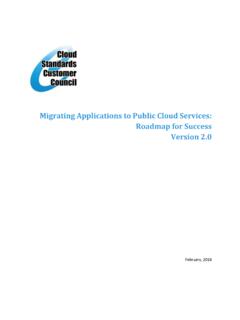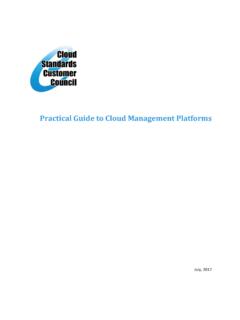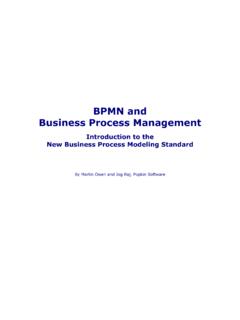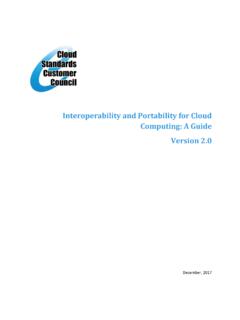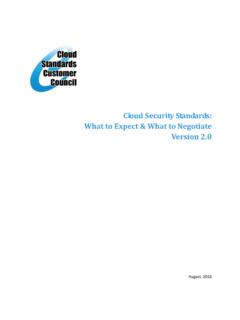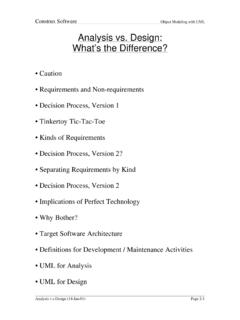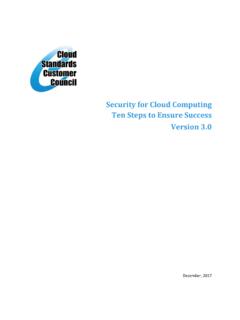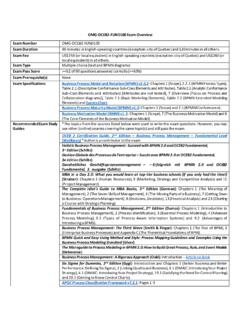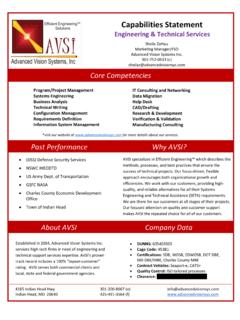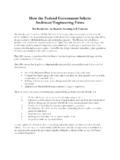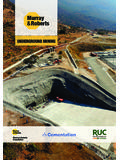Transcription of Putting Business Capabilities to Work - omg.org
1 Putting Business Capabilities to WorkJeff ScottVP/ Business & Technology StrategyOMGW ebinarJanuary 15, 2014 Who is Accelare? 2014 Accelare. Proprietary and confidential. Do not Writer: Currently publish the blog: The Business Architect Have written over 50 research reports and articles for Forrester Research, Cutter Consortium and others Speaker: Regularly speak at industry conferences, universities, user groups, and companies on the topics of strategy management, Business architecture, and organizational innovation Consultant & Mentor: Work with a small number of Business leaders and Business architects to facilitate their growth and success Business Architect AdvocateExperts in strategy execution and capability management1/15/1421/15/143 2014 Accelare. Proprietary and confidential. Do not CapabilitiesA quick overviewBusiness capability definedBusiness capability definition (one of many) A Business capability (or simply capability) describes a unique, collective ability that can be applied to achieve a specific outcome.
2 A capability model describes the complete set of Capabilities an organization requires to execute its Business model or fulfill its mission. An easy way to grasp the concept is to think about Capabilities as organizational level skills imbedded in people, process, and/or technology. ProcessCapabilitiesData gatheringConcept developmentCritical analysisResearchWriteEditPublishCapabili ties are applied to activities to create interim value points Processes structure activities to produce a value propositionThe result is a specific value delivery vehicle Service or productResearch Reports1/15/144 2014 Accelare. Proprietary and confidential. Do not link strategy to actionCapabilities: Define what an organization must be able to do to successfully execute its Business model Provide a common language for change Create a common link between executive intent and operational activities Provide a foundation for assessment and prioritization1/15/145 2014 Accelare.
3 Proprietary and confidential. Do not attributes Each capability is unique. A capability is a fundamental element of the organization and as such is clearly different from other Capabilities . A capability might be applied throughout the organization and can be applied in different ways to affect different outcomes but it is still a single capability. Capabilities are stable. Well-defined Capabilities rarely change. They provide a much more stable view of organizations than do projects, processes, applications, or even strategies. Capabilities only change when there is a significant shift in the underlying Business model or mission which might occur through a Business transformation initiative or in conjunction with a new merger or acquisition. This stability is a major part of their appeal. Capabilities are abstracted from the organizational model.
4 Capability models are not just a simple restatement of the enterprise s organizational model. They are organizationally neutral which means that changes in the organizational structure don t require a change in the capability model. In simple organizations, the capability model may indeed look similar to the corporate organizational structure; however, in more-complex organizations Capabilities both common to and unique to organizational units are 2014 Accelare. Proprietary and confidential. Do not attributes Capabilities can be defined for any organizational unit. Though most architects think of Capabilities at the enterprise level, every organization, large or small, has a set of Capabilities it applies to fulfill its mission. Since Capabilities represent the organization s leader s interest, each organization will have a unique set of Capabilities not seen in the rest of the organization.
5 Therefore, each organization will have a unique capability map. Individual Capabilities do not have a Capabilities represent what an organization can do and not what it actually does they can be viewed as potential. This means Capabilities can be applied in multiple ways, for different purposes. This also means they must be assessed in terms of their application - measured on a fit-for-purpose scale not a maturity scale. 1/15/147 2014 Accelare. Proprietary and confidential. Do not corollaries First and foremost Capabilities capture the organization s primary value in defining Capabilities lies in their ability to create new insight and perspective for Business leaders. To accomplish this, Capabilities must be defined in a way that resonates with Business executives thought process. Creating meaning is the goal. Coherence and completeness are not as important as resonating with Business thinking.
6 Capability models are not hierarchical. Though Capabilities can often be decomposed into lower level Capabilities the model is not entirely hierarchical. A lower level organization s capability model cannot be derived from the higher level model. Since Capabilities represent the organization s leader s interest, each organization typically has a unique set of Capabilities not seen in other organizational units as well as a set that is common with other organizations. Therefore, each organization within a single company typically has a unique capability map. 1/15/148 2014 Accelare. Proprietary and confidential. Do not 2014 Accelare. Proprietary and confidential. Do not capability models to workCapability models facilitate strategic decisions Which are our strongest and weakest Capabilities ? Which Capabilities provide strategic differentiation?
7 Which Capabilities can be leveraged in new markets? Where should we invest our resources? Where can technology add more strategic value? Where can technology be used to lower cost?1/15/1410 2014 Accelare. Proprietary and confidential. Do not models facilitate operational efficiencies Where do we have multiple processes and technologies supporting one capability? Which Capabilities are costing too much to support? Which Capabilities should we outsource? Where do we need more employee education? Where do we need process improvement?1/15/1411 2014 Accelare. Proprietary and confidential. Do not are not all equal in their VALUE to the customer and/or financial performance Assess Capabilities on value first1/15/1412 2014 Accelare. Proprietary and confidential. Do not create distinction in eyes of customers AND drive financial results Business Necessity Capabilities are necessary but are not seen as creating value for customers or driving financial performanceEssentialcapabilities drive financial performance but not customer ValueStrategic Supportcapabilities with high customer value but little Financial Divisional Support Business Process Publish IT Performance (to Customers)
8 Manage Customer Maintain Current State Manage Enterprise Manage IT Manage IT Create Annual Plan & Manage Research & Manage IT Plan Deliver Manage Program & Project Standards, Methods & Manage Requirements, Project Standards, Methods & Govern Portfolio & IT Resource IT Performance Execute IT IT Operational Tactical Manage IT Deliver Solution Estimation & Impact Define & Manage Solution Conduct Requirements Conduct Solution Design Construct Test Design Audit, Review & Deploy Decommission & Remove Define & Manage Service Manage Performance & Ensure Service Desk Manage Manage Manage & Administer Enable Business Recovery (DR) Coordinate & Accept Event Incident Deploy & Manage Service LevelsDeliver Operations InfrastructureSolutionsDelivery56IT Administration & Management4 Program & Project ManagementIT Planning & ControlsBusiness Partnership Management123 Business Necessity CapabilitiesEssential CapabilitiesStrategic Support CapabilitiesAdvantage CapabilitiesCapability assessment - IT Inc.
9 UNDERSTAND EACH CAPABILITY S VALUE CONTRIBUTION1/15/1413 2014 Accelare. Proprietary and confidential. Do not Value Index1/15/1414 2014 Accelare. Proprietary and confidential. Do not capability modelsExample 1: Build the strategic portfolio of workIDENTIFY CAPABILITY GAPS NECESSARY TO CLOSE TO REALIZE STRATEGIC PRIORITIES 1/15/1415 2014 Accelare. Proprietary and confidential. Do not planningIdea sourcingRapid prototypingSalesEngineeringMarket shapingIdentify capabilitiesSignificant improvementMinor enhancementFully supportsStrategic planningIdea sourcingRapid prototypingSalesEngineeringMarket shapingAssess capabilitiesStrategy: Bring more products to marketIdentify strategiesIdentify solutionsUse university research groups, outsource to overseas labs, crowd source from current customer baseRepeat for each strategyGap analysisIdea sourcingToday: working 5 new ideas per yearFuture: need at least 25 ideas per yearGap: increase idea generation 5 fold Rapid prototypingEngineeringRelegate idea generation to a small team of three product developersRoot cause analysisExample 1: Build the strategic portfolio of workCONSTRUCT THE STRATEGIC PORTFOLIO OF CAPABILITY ENHANCING WORK16 2014 Accelare.
10 Proprietary and confidential. Do not aligned capability enhancements create the portfolio of Market Market Sales Relationship Incident Product Repair Idea Rapid Packaging Channel Schedule Applied Line Inventory Distribution Order Order Human Financial Facilities Contract Strategic IT ManagementCorporate ManagementOrder To Cash56 Manufacturing To Distribution4 Concept To ProductRequest To ServiceProspect To Customer123 Example 2: Build a project funding filterCREATE FUNDING POOLS BASED ON CAPABILITY CONTRIBUTION 1/15/1417 2014 Accelare. Proprietary and confidential. Do not sourcingRapid prototypingLine managementQualitycontrolEngineeringPacka ging designMarket shapingSales ManagementOrder fulfillmentRelationship managementIncident managementStrategic planningApplied roboticsDistribution logisticsAllocate 50% of available fundingAllocate 20% of available funding Channel placementAllocate 30% of available fundingFabricationSchedulingInventory controlOrder managementBillingPaymentsMarket analytics Product educationRepair servicesHuman resourcesFinanceFacilities managementIT ManagementContract management Example 2: Build a project funding filterUSE FUNDING POOLS AS THE FIRST LEVEL PROJECT FILTER1/15/1418 2014 Accelare.
